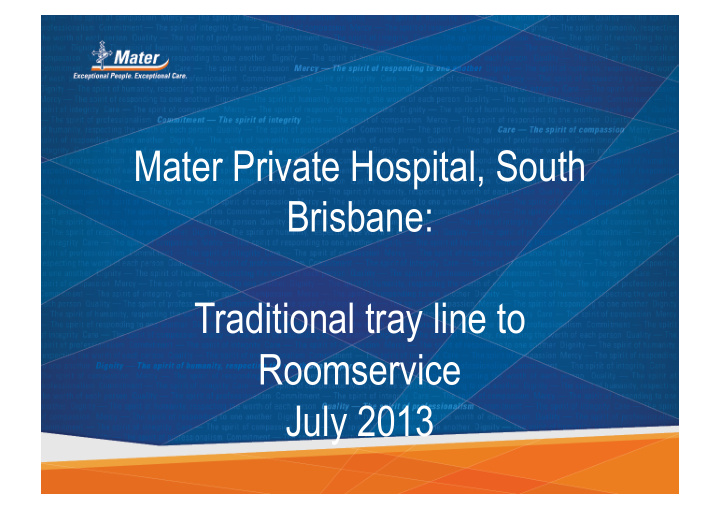



Mater Private Hospital, South Brisbane: Traditional tray line to Roomservice July 2013
Background & Issues – Pre July 2013 • 14 day cycle, semi integrated paper menu • Cook fresh and cook chill production • Traditional menu delivery in am → dinner, breakfast, lunch • Fully manual menu processing; paper and storage issues • Set meal times: BF @ 6am; L @ 12pm; D @ 5.30pm • Significant surgical and oncology population • Significant patient status and preference changes, movement • Issues related to diet communication and changes • Significant production time to produce “non-menu” items • Many late meal tray deliveries • Patient feedback – Press Ganey survey • Plate waste & kitchen waste
The Solution? The project while responding to consumer feedback, focused on ensuring a safe method of ordering and delivering meals, meeting the nutritional needs of the patient whilst creating efficiencies and minimising waste in production.
The Process • Engagement of DM&A (USA consultants) • Steering committee formed • Working groups formed IT menu HR and training marketing building and construction; procurement process planning • Multidisciplinary – F/S, N&D, Service Improvement Unit (& nursing), IT, marketing, HR, capital works
The Implementation • Workflow redesign – menu management, production, delivery, collection • Interface solutions • Database build, compliances, therapeutic diet revision • Training and education • Clinical process changes – nursing, allied health
The Product • Hotel style room-service model • One integrated menu with educational symbols (CHO, ♥ , GI ) • Meal service available 0630 – 1900hrs • All day breakfast; non breakfast menu items from 1100hrs • OPTIONS: 1. Room-service : Patients call for meals → call centre (RSR) → production (kitchen) → delivery within 45mins (DH) → dirty tray pickup within 1hr (DH) 2. Room-service Assist : bedside entry using ipads 3. Set Menu : standard/ default meals provided (3)
The Outcomes • Nil paper; less crowded menu office (call centre) • Real time menu change updates through CBORD • Improvement to diet allocation and patient changes • Production time dedicated to menu items • Reduction in meal delivery errors • Reduction in midmeals/ supplements produced • Nil late meal deliveries • Introduction of 3 patient identifiers on meal delivery • Patient feedback improved • Plate waste & kitchen waste reduction
The Metrics • Plate waste from 29%to 12% • Change in largest wastage items from protein/meat to milk/ tea/ coffee • Change in highest waste wards from surgical & onc/haem wards to CV and ortho wards • Change in most common reason for waste from nausea/ unwell to taste/ temp/ texture dislike Next step to correlate foodservice system and plate waste to nutritional intake and status • Consumer engagement: 80-100% consumers enjoy roomservice and rate it as improved meal service compared to previous model • Significant improvement in patient satisfaction surveys
The Learnings • Engage all stakeholders early – use the multidisciplinary team • Map all the processes early and use good project management methodology • Use the change process opportunity to improve other integral processes eg diet allocation, patient information transfer, pt identification • Listen to consumers
Phase 2 & Ongoing Phase 2 Ongoing Ordering Menu Phase Two – Upgrades to integration redesign with Visitors and service with Patient consumer relatives to delivery Entertainment feedback order software System
Ongoing Audit Matrix Ongoing Ongoing process outcome audits : audits – KPI’s Malnutrition ? Links between (meal quality, screening foodservice model (scripting & pt mealtime prevalence & and nutritional identifiers, diet environment, plate process audits status of patients allocation, queued waste, pt tickets) satisfaction)
Thankyou
Recommend
More recommend